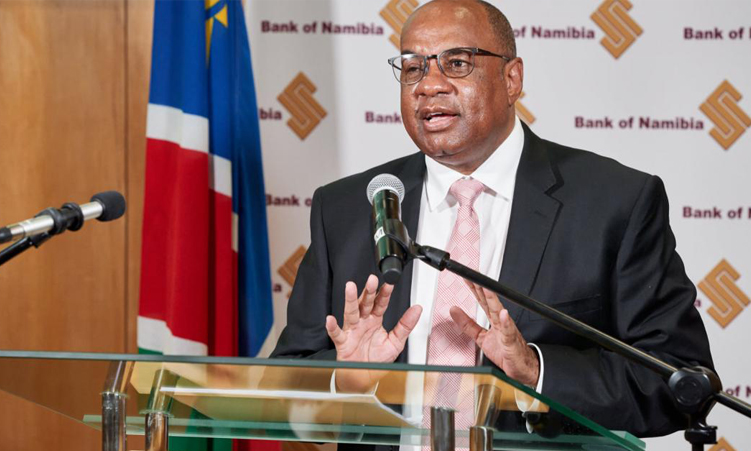17 April 2024
On 15 and 16 April 2024, the Monetary Policy Committee (MPC) of the Bank of Namibia held its second bi-monthly meeting for 2024 to decide on the appropriate monetary policy stance to be implemented over the next two months.
To continue safeguarding the peg between the Namibia dollar and the South African rand while supporting the domestic economy, the MPC decided to keep the repo rate at 7,75%. This decision was made following a comprehensive review of domestic, regional and global economic developments.
Recent economic developments
Domestic economic activity remained firm in 2023 and during the early months of 2024.
Inflation continued to ease, while the growth in private sector credit extension (PSCE) remained weak. The merchandise trade deficit narrowed, and the stock of international reserves remained sufficient to support the currency peg and meet the country’s international financial obligations.
Real gross domestic product (GDP) registered a slower, yet firm growth rate of 4,2% in 2023, compared to 5,3% recorded in 2022. The slowdown reflected weaker growth in the primary and secondary industries, especially in the agriculture and construction sectors, as well as the diamond mining subsector.
Meanwhile, economic activity was sustained by the tertiary industry, of which the growth rate edged higher during 2023. For the early months of 2024, economic indicators suggest that domestic economic activity increased further over this period, mainly observed in the mining, electricity generation, tourism and wholesale and retail trade sectors.
For 2024 as a whole, GDP growth is projected to moderate to 3,7% on account of the anticipated slower growth in the primary industry.
Risks to the domestic economic outlook have remained broadly unchanged since the previous MPC meeting, although the conflict in the Middle East has escalated notably.
External risks continue to reflect the prolonged tight global monetary policy stance, disruptive geopolitical tensions, and geo-economic fragmentation.
Internally, adverse risks mainly include uncertain rainfall patterns and water supply interruptions, particularly at the coastal towns.
Domestic inflationary pressures eased further since the previous MPC meeting. Overall inflation slowed to an average of 5% during the first quarter of 2024, from an average of 7% during the same period in 2023.
The deceleration was predominantly driven by food and transport price inflation. Likewise, inflation decelerated to 4,5% in March 2024, relative to the 5,4% for January 2024 reported at the previous MPC meeting.
Looking ahead, inflation is anticipated to slow down to 4,9% in 2024, 0,1 percentage point above the projection at the previous MPC meeting.
The slight upward adjustment is on account of persistent geopolitical tensions, which could potentially induce speculative spikes in oil prices, and uncertain rainfall conditions.
Annual growth in PSCE moderated to only 1,7% in February 2024 from the 1,9% for December 2023, which was reported at the previous MPC meeting.
Similarly, PSCE growth slowed to an average of 2% during the first two months of 2024, compared to 2,8% in the corresponding period in 2023. This was on account of lower credit demand by households, particularly in the categories of mortgages and other loans, advances and overdrafts.
Namibia’s merchandise trade deficit narrowed to N$5 billion during the first two months of 2024, which is 19,2% below its level in the same period of 2023 as export earnings surged, while import payments fell. The higher export earnings were mainly observed in mineral exports, particularly uranium and gold, which were supported by increased volumes exported and the exchange rate depreciation. Meanwhile, the decline in import payments was mainly due to lower imports of mineral fuels.
The stock of international reserves was lower at N$54,3 billion as at 31 March 2024, relative to the revised N$55,8 billion on 31 January 2024. The decrease was attributed to net commercial bank outflows and government foreign payments. At this level, the international reserves stock is estimated to cover 3,8 months of imports.
This remains sufficient to sustain the currency peg between the Namibia dollar and the South African rand, and, while meeting the country’s international financial obligations. The import cover, excluding hydrocarbon exploration-related imports, however, stood higher at 4,3 months.
Global output maintained positive growth in the fourth quarter of 2023, and is projected to remain resilient in 2024. Some inflationary pressures persisted in both the advanced economies (AEs) and the emerging market and developing economies (EMDEs). Most monitored central banks have kept their policy rates unchanged since the previous MPC meeting.
The global economy maintained positive momentum during the fourth quarter of 2023, with the Group of Twenty (G20) economies registering a growth rate of 3,2%, slightly above the 3% recorded in the preceding quarter.
The improvement was largely attributed to stronger performances in the United States (US) and India. For 2023 as a whole global growth came to 3,2%, slightly below the 3,5% recorded in 2022, partly due to restrictive monetary policies and the disruptive impact of geopolitical tensions.
Going forward, the International Monetary Fund projects the global economy to grow at the same pace of 3,2% in 2024, a 0,1 percentage point upward revision from the previous MPC sitting.
Prices of most key commodities have increased since the last MPC meeting. Accordingly, the price of gold increased to record-high levels most recently, mainly supported by safe-haven purchases.
Likewise, the uranium spot price remained high compared to a year ago, reflecting sustained long-term fundamentals related to strong demand for cleaner, safer and more secure energy, despite receding somewhat from its January 2024 high.
Zinc and copper prices have risen due to a tighter supply outlook and optimism around the Chinese economy. Food prices as measured by the United Nations’ Food and Agriculture Organisation Food Price Index ticked up recently, attributed to seasonal factors and uncertain weather conditions. On the contrary, diamond prices continued to trend downwards on the back of weaker global consumer demand.
Since the previous MPC meeting, most global equity markets trended higher up to the end of March 2024, compared to January 2024, buoyed by favourable risk sentiment. However, several stock markets recorded losses so far in April 2024 due to a hawkish US Federal Reserve, sticky inflation and the intensification of geopolitical tensions.
Bond yields in most monitored economies increased since the previous MPC meeting, as markets were adjusting to possibly more stubborn inflation and a potentially longer period before policymakers start reducing interest rates.
Most recently, inflation was sticky in most of the monitored economies. Among the AEs, inflation edged higher in the US and Japan, while it slowed in the United Kingdom and the Euro Area. In the EMDEs, inflation rose in China, South Africa and Russia, and receded in Brazil and India.
Likewise, inflation in most key economies edged higher, compared to the previous MPC meeting. Looking ahead, global inflation is anticipated to slow from an estimated average of 6,8% in 2023 to an average of 5,9% in 2024, slightly above the level reported at the previous MPC meeting.
Monitored central banks kept their policy rates unchanged at their most recent monetary policy meetings, except for the Bank of Japan and the Central Bank of Brazil, which raised and cut rates, respectively. While inflation remains generally lower than a year ago, underlying inflation is still elevated, hence most central banks have exercised caution with their stance at recent MPC meetings.
Monetary policy stance
The MPC noted the persistence of global inflation and a range of inflation risks, but took comfort in the downward trend in domestic inflation and the positive level of domestic real interest rates which help to contain inflationary pressures.
The level of international reserves was deemed adequate, while the overly subdued domestic credit growth remained a concern. Against this backdrop, the MPC decided to keep the repo rate unchanged at 7,75%.
Likewise, the prime lending rate remains steady at 11,50%. This policy stance will continue to safeguard the one-to-one link between the Namibia dollar and the South African rand and support domestic economic activity.
The MPC views it as important for monetary policy to create and maintain an environment of stability and certainty.
The next MPC meeting will be held on 17 and 18 June 2024.
Stay informed with The Namibian – your source for credible journalism. Get in-depth reporting and opinions for
only N$85 a month. Invest in journalism, invest in democracy –
Subscribe Now!






